Related Research Articles

Dalit, also some of them previously known as untouchables, is the lowest stratum of the castes in the Indian subcontinent. Dalits were excluded from the four-fold varna of the caste hierarchy and were seen as forming a fifth varna, also known by the name of Panchama. Several scholars have drawn parallels between Dalits and the Burakumin of Japan, the Baekjeong of Korea, the Hukou system of China and the peasant class of the medieval European Feudal system.
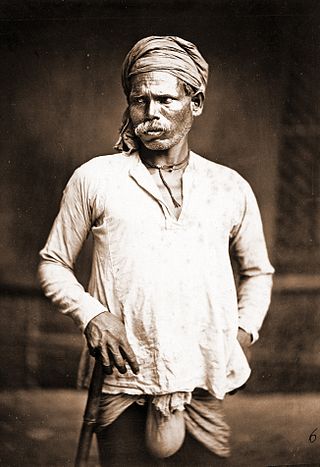
The Dom, also known as Domra, Domba, Domaka, Dombara and Dombari, are castes, or groups, scattered across India. Dom were a caste of drummer. According to Tantra scriptures, the Dom were engaged in the occupations of singing and playing music. Historically, they were considered an untouchable caste called the Dalits and their traditional occupation was the disposal and cremation of dead bodies. They are in the list of Scheduled caste for Reservation in India in the Indian states of Uttar Pradesh, Bihar, Odisha, Andhra Pradesh, Jharkhand and West Bengal.
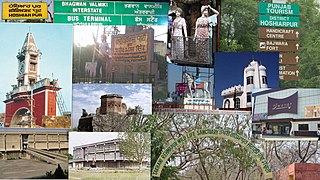
Hoshiarpur is a city and a municipal corporation in Hoshiarpur district in the Doaba region of the Indian state of Punjab. It was founded, according to tradition, during the early part of the fourteenth century. In 1809, it was occupied by the forces of Maharaja Karanvir Singh and was united into the greater state of Punjab in 1849.
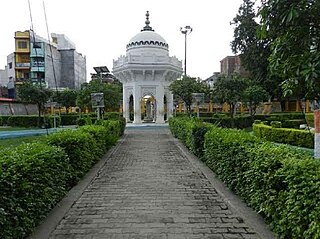
Ballia is a city with a municipal board in the Indian state of Uttar Pradesh. The eastern boundary of the city lies at the junction of two major rivers, the Ganges and the Ghaghara.The city is situated 140 km (87 mi) east of Varanasi and about 380 km from the state capital Lucknow. It has a protected area, the Jai Prakash Narayan bird sanctuary. Ballia is also around 4 km (2.5 mi) away from Bihar.

Agra is one of the 75 districts in the northern Indian state of Uttar Pradesh. The district headquarters is the historical city of Agra. Agra district is a part of Agra division.

Chamar is a Dalit community classified as a Scheduled Caste under modern India's system of affirmative action. They are found throughout the Indian subcontinent, mainly in the northern states of India and in Pakistan and Nepal.
Chuhra, also known as Bhanghi and Balmiki, is a Dalit caste in India and Pakistan. Populated regions include the Punjab region of India and Pakistan, as well as Uttar Pradesh in India, among other parts of the Indian subcontinent such as southern India. Their traditional occupation is sweeping, a "polluting" occupation that caused them to be considered untouchables in the caste system.

Jalandhar district is a district in Doaba region of the state of Punjab, India. The district headquarters is the city of Jalandhar.

Punjabi Hindus are adherents of Hinduism who identify ethnically, linguistically, culturally, and genealogically as Punjabis and are natives of the Punjab region of the Indian subcontinent. Punjabi Hindus are the second-largest religious group of the Punjabi community, after the Punjabi Muslims. While Punjabi Hindus mostly inhabit the Indian state of Punjab, as well as Haryana, Himachal Pradesh, Delhi, and Chandigarh today, many have ancestry across the greater Punjab region, which was partitioned between India and Pakistan in 1947.
Ravidassia or the Ravidas Panth is a religion based on the teachings of Guru Ravidas. It was considered a sect within Sikhism until 2009. However, some Ravidassias continue to maintain Sikh religious pratices, including the reverence of the Guru Granth Sahib as their focal religious text, wearing Sikh articles of faith (5Ks), and appending Singh or Kaur to their names.
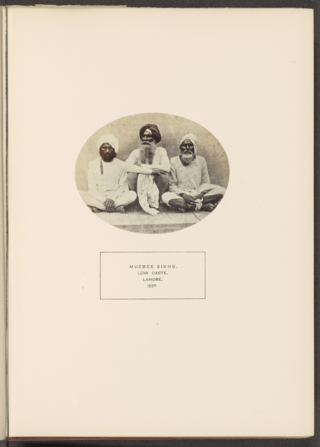
Mazhabi Sikh is a community from Northern India, especially Punjab region, who follow Sikhism. Mazhabi are part of wider category of Dalit Sikhs, who convert from the hindu Valmiki community. The word Mazhabi is derived from the Arabic term mazhab, and can be translated as the faithful. They live mainly in Indian Punjab, Rajasthan and Haryana.

Sansi are a formerly nomadic people from India that were classified as a criminal tribe in the 19th century by the British during the Raj period. They were stealing food supply from British Government. That's why the British government declared them thief They claim Rajput descent. There were two distinct offshoots of the tribe: the first was a vagrant community connected to the Jat tribes of Central Punjab; the second was an agricultural Jat clan found in Sahiwal, Amritsar and Gujranwala.
Adi Dharm refers to the religion of Adi Brahmo Samaj the first development of Brahmoism and includes those Sadharan Brahmo Samajists who were reintegrated into Brahmoism after the second schism of 1878 at the instance of Devendranath Tagore. This was the first organised casteless movement in British India and reverberated from its heart of Bengal to Assam, Bombay State, Punjab and Madras, Hyderabad, and Bangalore.
Punjab is home to 2.3% of India's population; with a density of 551 persons per km2. According to the provisional results of the 2011 national census, Punjab has a population of 27,743,338, making it the 16th most populated state in India. Of which male and female are 14,639,465 and 13,103,873 respectively. 32% of Punjab's population consists of Dalits. In the state, the rate of population growth is 13.9% (2011), lower than national average. Out of total population, 37.5% people live in urban regions. The total figure of population living in urban areas is 10,399,146 of which 5,545,989 are males and while remaining 4,853,157 are females. The urban population in the last 10 years has increased by 37.5%. According to the 2011 Census of India, Punjab, India has a population of around 27.7 million.
The Gadaria or Gadariya is a herding caste that was traditionally involved professionally in livestock breeding, especially sheep. They are primarily found in Uttar Pradesh and in some parts of Punjab, Rajasthan, Madhya Pradesh and Bihar. In Gujarat, they are called Bharwad.

The 2011 census of India or the 15th Indian census was conducted in two phases, house listing and population enumeration. The House listing phase began on 1 April 2010 and involved the collection of information about all buildings. Information for National Population Register (NPR) was also collected in the first phase, which will be used to issue a 12-digit unique identification number to all registered Indian residents by Unique Identification Authority of India. The second population enumeration phase was conducted between 9 and 28 February 2011. Census has been conducted in India since 1872 and 2011 marks the first time biometric information was collected. According to the provisional reports released on 31 March 2011, the Indian population increased to 1.21 billion with a decadal growth of 17.70%. Adult literacy rate increased to 74.04% with a decadal growth of 9.21%. The motto of the census was Our Census, Our Future.
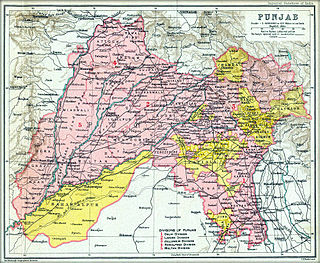
Delhi's ethnic groups are diverse. The Yamuna river's flood plains provide fertile alluvial soil suitable for agriculture but are prone to recurrent floods. The Yamuna, a sacred river in Hinduism, is the only major river flowing through Delhi. The original natives of Delhi are those whose ancestors lived in the Yamuna basin, a region which spreads radially from the capital up to a distance of approximately 200 kilometres. Another theory suggests that "The original inhabitants of Delhi, are the Jats, Gujars, Rajputs of Tomar and Chauhan clans" respectively. This province was not ethnically homogeneous and large amounts of Hindi-speakers resided in the southeast, now Haryana, eastern side, now West Uttar Pradesh and in Delhi's Yamuna Basin. Today the migrant population consists largely of Punjabis, Haryanavis, Bengalis and recently,' Biharis and Uttar Pradeshis etc.
The Rai Sikh is a Sikh community, mainly found in the states of Punjab, Rajasthan, Uttar Pradesh, Uttrakhand, Delhi and Haryana in India.
Ghar Wapsi is the programme of religious conversion to Hinduism from Islam, Christianity, and other religions in India conducted by Indian Hindu nationalist organisations Vishva Hindu Parishad (VHP), Rashtriya Swayamsevak Sangh (RSS) and their allies. The term owes to the Hindu nationalist ideology that all people of India are ancestrally Hindu and, hence, conversion to Hinduism is one of "returning home" to their ancestral roots.
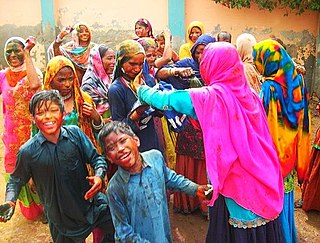
Hinduism is a minority religion in Punjab province of Pakistan followed by about 0.2% of its population. Punjab has the second largest number of Hindus in Pakistan after Sindh. Hinduism is followed mainly in the Southern Punjab districts of Rahim Yar Khan and Bahawalpur.
References
- ↑ Valmiki Hindu Jati (in Hindi). 19 January 2021. ISBN 9789350485668.
- ↑ "बैठक: पूर्व मंत्री कृष्ण कुमार बेदी के समर्थन में उतरा वाल्मीकि समाज, आज फिर बुलाई महापंचायत". Dainik Bhaskar (in Hindi). 28 October 2020. Retrieved 23 February 2022.
- ↑ "Punjab: Data Highlights: The Scheduled Castes" (PDF). Census I. 2001. Retrieved 5 January 2015.
- ↑ "Delhi: Data Highlights: The Scheduled Castes" (PDF). Census India. 2001. p. 1. Retrieved 5 January 2015.
- ↑ Leslie, J.(2003) Authority and Meaning in Indian Religions: Hinduism and the Case of Valmiki. Ashgate publishing their favorite weapon is karha . ISBN 0754634302
- ↑ "A-10 Individual Scheduled Caste Primary Census Abstract Data and its Appendix - Uttar Pradesh". Registrar General & Census Commissioner, India. Retrieved 4 February 2017.
- ↑ Jacobs, Stephen (2010). Hinduism Today: An Introduction. A & C Black.
- ↑ "Memorandum submitted by Central Valmiki Sabha International (UK)". United Kingdom Parliament. 12 November 2009. Retrieved 19 May 2015.